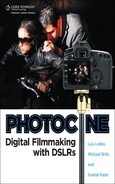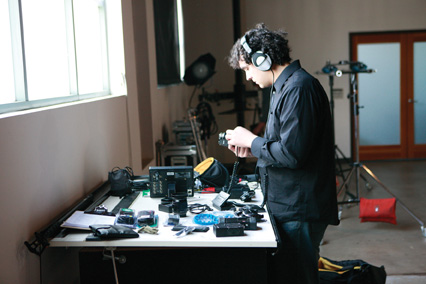
After reading the previous chapters, you’ve likely come to the conclusion (like we all have) that compared to stills photography, filmmaking requires a vast skill set, significantly more gear, additional crew members, post-production knowledge, and a larger budget. Where does that leave the still photographer who’s trying to keep his or her business alive in a tough and constantly changing market? Don’t despair, because there are many ways to incorporate motion into your photography business that don’t require a complete overhaul to your stills workflow.
The very first video I shot was with the Canon 5D Mark II. It was a fashion portrait on the day that the firmware was released, thus allowing manual exposure controls. I shot it with the tripod locked down using lighting gear that I was familiar with. I rented an older Profoto HMI to go inside a Profoto beauty dish and shot it the same way I would have if it were a stills shoot. As a matter of fact, I set up the camera to take high-quality RAW stills during video capture when the shutter is activated.
For this shoot, I rented or borrowed a bunch of HDSLR accessory gear including a Cinema Rig from Redrock Micro, a Marshal battery, powered LCD monitor, a Hoodman viewfinder loupe, and a Manfrotto 503HD fluid tripod head (which I had no experience with and used frugally).
My friend and employee at the time, Greg De Stefano, called a friend of his who lived near our Santa Monica studio and asked her to be our test subject. We set the camera up for 30fps (24fps was not yet an option) with a shutter speed of 1/90th of a second (breaking the 180° rule, which was unknown to us at that time) and selected the Neutral picture style with beefed up saturation and contrast. We shot some stills as digital Polaroids to check the highlight and shadows of our lighting and then created Lightroom adjustment settings to reflect the camera picture style for the stills.
Tip
Everyone kept telling me that I’d be ruining the best parts of the video by interrupting it for the still capture process, which blacks out the video for about a second while capturing a still. I was pretty sure I could shoot this way based on the fact that I am not really a spray-and-pray kind of photographer. I cut my teeth as a starving artist by using a Pentax 6×7 film camera with no Polaroid. I’ve done paid jobs in my early days with two rolls of film, which is 20 shots, and no way to preview the final image. I also recognized that on a commercial, two or three seconds of continuous footage between cuts is pretty much the norm. I was able to get good stills and video as I suspected by being selective when shooting. When you watch the test video, keep in mind that every frozen frame had a stills counterpart, so you can see the stills I was able to capture the video. I realize this isn’t everyone’s cup of tea, but I find it to be an intuitive way for me to work.
The point of my test was to see if it was practical to shoot stills and video with the same settings and to get our feet wet with DSLR video as a deliverable. The reason we set the video up with high saturation and contrast was to create the look in-camera, thus limiting any post-processing. You can see this video at http://vimeo.com/5238050. By the way, this was also a proof of concept for vertical video, so be sure to watch it in full frame view. The shutter sound you hear is the camera shutter actuation being recorded via the on-camera microphone. The flashes were added in post as visual transitions.

Check out the video of this fashion shoot at http://vimeo.com/5238050
The hardest part of this test was getting online video sites to recognize the vertical orientation. QuickTime just flags the metadata as vertical, which isn’t always recognized. I ended up having to export the video out with the resolution settings switched from 1920×1080 to 1080×1920 (the actual settings of this video are 640×1136 for ease of online viewing).
My next experiment was to shoot a motion Magazine concept using the RED ONE camera, shown in the next figure. The video files from the RED ONE camera are larger and can be used for magazine print work when exported individually. Steven Klein has done this on several occasions for W magazine and Greg Williams for Esquire, which incidentally has a great animated GIF of a Megan Fox cover teaser (see http://www.esquire.com/the-side/video/megan-fox-images-0609).
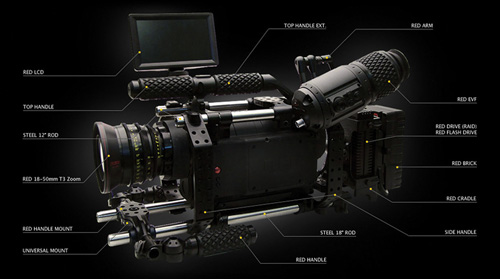
The RED ONE camera, a registered trademark of Red.com, Inc.
This test was to find out the viability of using a RED ONE movie camera for stills video hybrid work and to determine the difficulty of creating a motion magazine cover in Photoshop without using a video-editing suite. I was still mostly interested in the vertical format for video because most magazines use vertical-orientated imagery, and I envisioned it being adopted for motion magazines and digital signage. This assumption proved correct as the iPhone 3Gs and 4 opened the door to vertical-oriented consumer videos, and the iPad showcases vertical video nicely.
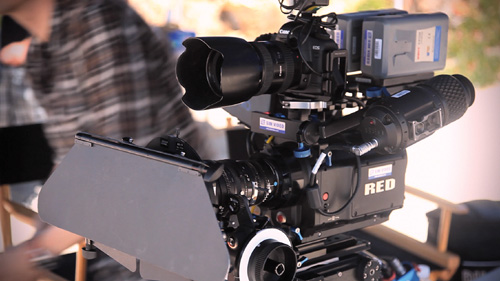
Alexx Henry shooting Outside Magazine’s living image cover with a RED ONE.
The first thing I learned while shooting fashion with the RED ONE was that you lose the connection with the subject when there is a big honking camera between you that takes two people to move around. You become more of a DP watching on a monitor than a still photographer making a personal connection. Other than that, the RED ONE camera produces beautiful files that can be easily manipulated in Photoshop’s Animation timeline (available in PS Extended version and higher).
Once dropped onto the motion timeline, you can make adjustments using curves and all the tools you are familiar with as a photographer. I added text that popped up at various intervals and even changed the background color for the moving image. All of this was done in the PS Animation timeline, which is now available on CS5 extended when you select Motion as your workspace palate. You can see this video at http://vimeo.com/13709283.
Editing in Photoshop Extended will work with DSLR video as well as RED footage, which is why I have mentioned it here as an alternative to video-editing suites. Both of these videos were done with the same basic tools that are used by digital photographers on a daily basis and are a good example of how to start delivering motion to your clients. Keep it simple and use your eye as a photographer to create interesting moving visuals.
My friend Alexx Henry was an early adopter for shooting motion magazine content and has really set the bar high for the rest of us. His early work on a Cybill Shepherd Hallmark project (see http://vimeo.com/5004964) set his path toward shooting moving one-sheets and motion magazine materials, which culminated in an amazing piece for Viv Mag at http://vimeo.com/10207926. This interactive feature spread really redefines what a motion magazine can be and is one of the best examples of incorporating motion into a magazine format.

Cybill Shepherd in “Mrs. Washington Goes to Smith”.

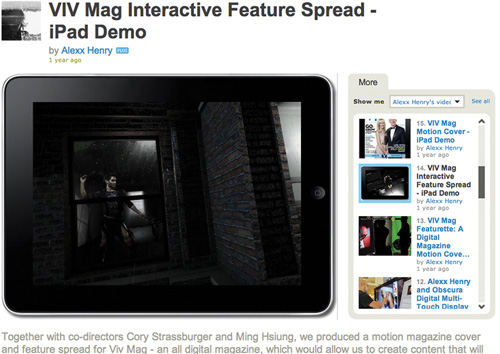
Check out Alexx Henry’s Viv Mag piece at http://vimeo.com/10207926
The kind of projects that Alexx is working on are collaborative and require huge budgets with large crews (compared to stills shoots), but you can use your photographic eye to create really interesting motion projects that can be accomplished on your own without using a special effects team of CGI artists.
One of the ways to do that is to take a look at what photographers like the NY team of Jamie Beck & Kevin Burg are doing. They have coined the term cinemagraph to describe the artful, high-style animated GIFs that they’re making from HDSLR video footage. These aren’t your flashing car salesman style GIFs that littered the virtual landscape in 1999. These are smart, well-thought-out graphical images that are frozen in time with the exception of a small isolated section of movement like hair blowing in the wind or a string of lights swaying over a static party scene. These cinemagraphs play to a photographer’s strengths and are fairly easy to execute. I would argue that they can play an important role in the emerging fields of digital signage and motion advertising. Check out Jamie and Kevin’s GIF work at http://fromme-toyou.tumblr.com/tagged/gif.
Tip
The thing to keep in mind about GIFs is that the color palate is limited to 256 colors, so the images need to be fairly monochromatic or desaturated. I think this actually adds to the visual dialogue, helping to set artful GIFs apart from straight video.
If you’d like to learn how to produce your own cinemagraphs in Photoshop, check out the instructional video from Adobe’s Russell Brown at http://av.adobe.com/russellbrown/WindyHair_SM.mov.
Movie posters were an obvious choice for early adopters of motion imagery, and they are also good candidates for cinemagraphs. One of the first motion posters I noticed was shown as a teaser for the Will Ferrell movie Step Brothers. It came on the screen after the lame slide show and coke quizzes that are shown before the previews start. The shot appeared to be another still of the movie poster, but after a brief static pause, Will reaches over and sticks his finger in John Riley’s ear. After that, they argue while posing for the photo. This caught audiences by surprise and made them laugh, which was good marketing for a comedy. You can see the official Step Brothers living poster at http://www.youtube.com/watch?v=gUJ-gFus7Ww.
I’d like to see more of these motion movie posters on the web, and I think that an animated GIF is the perfect format that’s currently being overlooked probably due to the bad legacy of annoying flashing GIFs.
Another area in which photographers can provide simple content is with digital signage. This field is in its infancy and struggling to grow up in a financially-wary economy, but I think it will soon provide an avenue for creative image makers who can deliver compelling content.
With few exceptions, motion digital signage is currently relegated to kiosks in the mall. A lot of this is due to regulations designed to prevent distracted drivers from having a wreck while watching outdoor video content.
In its current incarnation at malls, it’s usually just video repurposed for whatever hardware is being used to show the footage. This is unfortunate and often ineffective.
I have a screenwriter friend who heard that one of her movies had a motion poster at the Glendale Galleria, so we went over to check it out. There were these lame kiosks set up interrupting the flow of traffic in the main walkway, and they were playing horizontal commercials inside a vertical image frame. The whole implementation was no better than embedding a TV into a cardboard cutout movie poster—lame. I was curious about how effective these digital signs were, so I sat on a nearby bench watching to see if anyone paid them any attention. Not one person stopped or even glanced at the ads. We are so used to tuning out blaring TVs in bars, restaurants, doctors’ offices, the gas pump, and everywhere we are assaulted by their intrusive sights and sound. These kiosks were a total waste of time and space, especially to the youth market that advertisers seek out with such reckless abandon. This youth market is used to selecting their content through downloads, instead of being fed passive entertainment.
Now imagine, as I did while setting there on that bench, what if one of the giant posters of beautiful models in the window of a high-fashion clothing store changed poses every now and then? Or better yet, she moved when set off by a motion detector when you come into close proximity to the storefront. Wow, I bet almost everyone would stop and take notice of that, the same way the audience laughed at the Step Brothers motion poster.
I expect to see some better implementation in the future as technology advances and more research is done in this field. I predict a perfect time for animated GIFs like cinemagraphs will be during the rise of epaper large enough to be used for signage. The video shown on epaper will be restricted in file size and complexity as the technology matures. The restricted file sizes created by GIFs on the Internet of the 90s will be perfect candidates for epaper signage technology.
Another way into the stills motion landscape is with time lapse photography. Time lapse is where you take a series of still images at a specified interval, such as 1 to 5 seconds apart. Then you animate those images and turn them into a single video, which appears to make time go faster (or in other words, lapse). This is a form of stop-motion photography, and it can be used for many purposes. It’s really hot right now, and you can see it used for transition scenes in films/TV, in advertising spots for HBO, and on several high-profile music videos. As a matter of fact, HDSLR cinematographer Alex Buono shot the opening scene of a new series called Detroit 187 as a time-lapse sequence of sunrise over downtown Detroit, which he talks about on our PhotoCine Expo DVD.
Time lapse video is easy to produce. It takes more patience than gear. All you really need is a tripod and intervalometer capabilities (which is the ability to take a photo at set intervals). Intervalometers can be quite expensive, and I can’t really tell why. The functionality is very primitive and shouldn’t require more technology than a 1980s Casio watch. Most intervalometers only have four simple functions. I’ve had good luck buying inexpensive Chinese ones from eBay for $20, instead of paying over $150 for name-brand units.
All of the ideas I mentioned in this chapter can be ways to get started using the motion capture capabilities of modern still cameras without having to form a production company and make motion pictures. There will always be a market for great imagery—moving or still—and following these examples, you should be able to walk the line as a hybrid photographer or as a photocine specialist.
